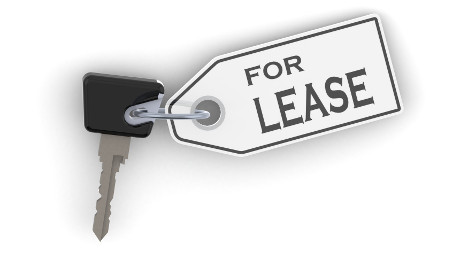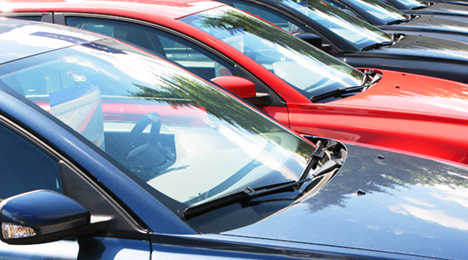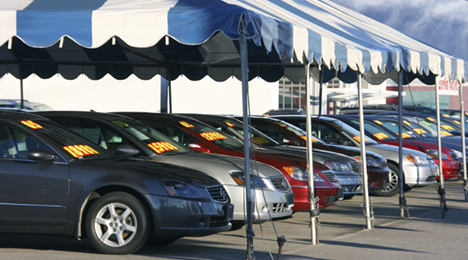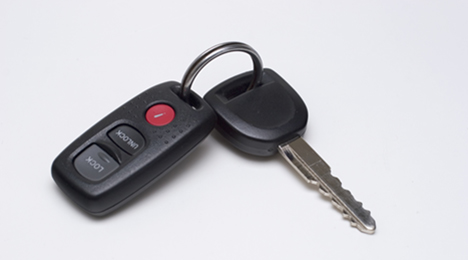Manheim Consulting indicated new-vehicle leasing increased by more than 10 percent year-over-year during the first quarter, marking the eighth quarter in a row the market penetration rise has been by at least that amount.
During his quarterly conference call on Monday, Manheim chief economist Tom Webb explained how that development might be pointing toward another trend besides more potential inventory for franchised dealers to grow certified pre-owned sales.
“Interestingly, even though total new-vehicle sales in the first quarter were basically flat after a poor January and February, the retail lease penetration rate was up, and fleet sales were down. As a result, new-lease originations grew by more than 10 percent in the first quarter,” Webb said.
Because of what happened in Q1, Manheim slightly modified its off-lease volume estimates for 2015 and beyond, projecting the level could approach 3.5 million units five years from now.
Then, Webb dived back into what else growing lease penetration might mean.
“It should be noted that the increase in lease returns will approximate the increase the total increase in new-vehicle sales this year. Next year, I would fully expect that the increase in lease returns will likely exceed the increase in total new-vehicle sales,” Webb said.
“So what we have is what I would characterize is that we no longer have a new-vehicle market that is supported by pent-up demand. We have one that is supported by lease returns, and that’s a good thing,” he continued.
“But you all know I have my bias,” Webb went on to say. “If you consider that new vehicles are increasingly being bought by high-income households that do in fact want to trade on a regular cycle, then they should be in a lease and not a retail contract. Because remember, residual risk always has to reside somewhere. How better for that risk to reside with the lessor who has a portfolio of vehicles and hopefully has a professional remarketing arm.”
Even with the increase in off-lease volume, Webb pointed out that Manheim is forecasting that 2014 CPO sales are estimated to be greater than the total year-end off-lease supply. He noted that situation also unfolded in 2012 and 2013. Manheim’s data showed off-lease volume stood at about 2 million vehicles in 2011 with CPO sales settling a few thousands units below that figure.
When asked by Auto Remarketing, Webb discussed specifically when off-lease volume might increase as this year continues.
“It accelerates as the year progresses to the certain extent that new leases are sometimes written with contracts so they don’t come due in the weakest part of the cycle in November and December,” Webb said.
“There is still opportunities to pull leases ahead. I think you’re going to see more of that because the numbers are big and one of the advantages of leasing is that it maintains brand loyalty,” he continued. “By the same token, if you’re one of the other brands, you want to get it and capture that customer before they return back to that brand so you’ve got some marketing techniques you can use. And one of the strategies is pulling that lease ahead to capture the customer.”
LeasePlan USA has announced that it has expanded its sales force, adding Mike Zalas to its client acquisition team.
Zalas will serve as the vice president of sales, national accounts, where he will be responsible for "delivering high-touch service" throughout the North Central region, the company shared.
Zalas brings with him more than 12 years of professional sales experience, including a decade in the fleet management industry.
Previously, Zalas worked as director of business development at the company, “where he created customized fleet management solutions tailored to his clients' specific fleet needs,” company officials said.
The company pointed out Zalada also “excelled” in the cultivation of new relationships while providing account management.
Mike currently serves on the Board of Directors as the program committee chair for the Chicago NAFA (National Fleet Management Association) chapter.
“Mike’s sales and industry experience is just the tip of the iceberg when it comes to his many attributes. He is innovative and creative, which is instrumental in creating customized fleet solutions for his clients. I look forward to the fresh perspective Mike will provide new clients to help them reach their goals and I know he will deliver on our promise to make it easier to leaseplan,” Jon Toups, chief sales and marketing officer.
Following a few months on the downward tilt, average monthly payments for leases on the road climbed last month, but this increase doesn’t appear to have put a damper on the popularity of leasing, says Swapalease.com.
In an analysis released Tuesday, the site indicated that the average monthly lease payment in February for cars on the road was $591.70.
In January, the average payment was $572.42, and in February 2013, the payment was $569.23 on average.
“Our data show that the average lease payment for vehicles on the road today reversed course from the previous months,” said Scot Hall, executive vice president for Swapalease.com. “This increase in price is not having a negative impact on sales, though, as leasing levels remain near all-time highs and dealerships continue to focus on leasing in their advertising.”
Among the most popular rides, the largest year-over-year drop was for the Chevrolet Volt. In February, its average payment was $297.56, compared to $424.50 in February 2013.
“The aggressive lease deals and incentives on Volt leases 12-16 months ago reflect the falling monthly payments drivers are recording on vehicles in service today,” Swapalease explained in its analysis.
Meanwhile, another Chevrolet model, the Cruze, showed the largest year-over-year increase. Its $265.87 average monthly payment is up from $231.40 in February of last year.
Swapalease explained that the payment figures “are extracted from car leases that have been in service for an average of 17 months since lease inception.”
It is clear that leasing is becoming more and more popular, as many recent reports would suggest, but one finding from Swapalease.com, in particular, could be quite important for the leasing community to consider: many women may not return to leasing when they go to find their next vehicle.
Why?
To answer the question, Swapalease conducted a survey and found that many women don't like the lack of equity in a lease scenario, and getting a good deal is the most frustrating part of leasing for them.
The survey asked more than 1,000 drivers a wide array of questions about the leasing process, and these general trends arose:
1. Many women aren’t familiar with lease transfer.
2: Women are looking for shorter lease commitments.
3: Women have lower down payments.
4: Women may not return to leasing.
5: Credit applications and lack of equity frustrate women lease shoppers.
The following are exact results of the survey questions and commentary from Swapalease.com analysts:
Did you know that vehicle leases are transferrable to others?
| Answer |
Men |
Women |
| Yes for all makes |
25.3% |
7.8% |
| Yes for some makes |
28.8% |
22.8% |
| Did not know |
45.7% |
69.3% |
How important is it that your vehicle lease is transferrable?
| Answer |
Men |
Women |
| Extremely important |
3.5% |
5.2% |
| Very important |
5.7% |
1.7% |
| Important |
15.5% |
9.6% |
| Slightly important |
20.0% |
12.2% |
| Not important |
39.5% |
38.6% |
| Did not know |
15.5% |
32.4% |
Do you know if your vehicle lease in transferable?
| Answer |
Men |
Women |
| Yes |
27.5% |
14.0% |
| No |
34.6% |
31.5% |
| Did not know |
37.7% |
54.3% |
Swapalease.com Analysis: Lease transfer is something that is not promoted at the dealership, nor by the lease company. This barrier to exposure limits the full experience possible for leasing a vehicle, one that has been proven to enhance the overall experience. It is our belief that more women would consider leasing if they fully knew of the option to transfer and all the benefits that are presented through the lease transfer experience either as a buyer or seller.
What is the ideal term for a vehicle lease?
| Term |
Men |
Women |
| 12 months or less |
0.4% |
1.7% |
| 18 months |
2.2% |
2.6% |
| 24 months |
24.4% |
27.1% |
| 36 months |
65.7% |
63.1% |
Which of the following apply to you?
| Reason |
Men |
Women |
| Want out of my lease early |
10.6% |
20.1% |
| Tired of driving my lease |
6.2% |
11.4% |
| Want a newer lease now |
16.0% |
16.6% |
| Lease no longer fits lifestyle |
8.0% |
12.1% |
| Cost of current lease too much |
14.2% |
17.5% |
Swapalease.com Analysis: According to this data, a larger percentage of women drivers would prefer lease terms that are 24 months or less, compared with the majority of men who indicated a stronger interest in longer terms such as 36 months. Additionally, a larger percentage of women indicated they get bored with their lease earlier than men, which may indicate a stronger desire to drive different vehicles even more frequently. As a side note, this percentage may be even higher assuming more women were familiar with the concept of lease transfer.
How much money, in total, did you put down when you got your leased vehicle?
| Total |
Men |
Women |
| $0-$500 |
33.8% |
42.9% |
| $500-$1000 |
14.2% |
12.3% |
| $1000-$3000 |
34.0% |
35.0% |
Swapalease.com Analysis: In a possible sign of savvy consumerism, a higher percentage of women indicated they put less money down on a lease, sometimes even no money. This tells us that zero-down lease deals may appeal stronger to women during the shopping process.
How likely are you to lease your next vehicle after your current lease expires?
| Likelihood |
Men |
Women |
| Definitely |
29.7% |
28.0% |
| Probably |
34.2% |
24.5% |
| Maybe |
25.7% |
33.3% |
| Probably Not |
6.2% |
10.5% |
What is the most frustrating part of negotiating a vehicle lease?
| Reason |
Men |
Women |
| Mileage Requirements |
21.3% |
17.5% |
| Understanding Taxes |
4.8% |
3.5% |
| Lease Language |
22.6% |
11.4% |
| Getting A Deal |
40.4% |
37.7% |
| Paperwork |
16.8% |
14.9% |
| Credit Approval |
2.6% |
6.1% |
| Car Salesperson |
23.5% |
24.5% |
| Confusing Process |
10.2% |
6.1% |
| No Equity |
13.3% |
21.9% |
| Lease Return |
15.1% |
13.1% |
| Payment Negotiation |
25.7% |
21.9% |
Swapalease.com Analysis: A larger percentage of women say they are not likely to lease the vehicle that follows their current lease. Women indicate that the credit approval process is more frustrating than men, yet this takes place at the time of purchase. Secondly, more women indicated a frustration with not having any ownership stake in the vehicle during the lease process, which may be a larger indicator of their low desire to lease their next vehicle. What’s interesting here is that this is counter to earlier insight showing women as being more interested in driving a different vehicle more frequently, a popular benefit to leasing.
When it comes to the new-vehicle lease market, there were three brands in a close race to lead market share in the fourth quarter, according to data from Experian Automotive.
Honda, which took an 11.1 percent share of the new lease market, edged out Ford (11.0 percent) and Toyota (10.6 percent).
This trio was followed by Nissan (7.5 percent), Chevrolet (6.0 percent) and Mercedes-Benz (5.8 percent). Rounding out the top 10 in Experian’s data set were BMW and Volkswagen (both at 4.9 percent), Lexus (4.6 percent) and Hyundai (4.1 percent).
As one might expect, when Experian calculated which brands had the greatest lease concentration (percent of their new sales that were leases), luxury brands dominated.
Smart led the way at 69.5 percent and was followed by Infiniti (59.3 percent), Lincoln (53.2 percent) and BMW (52.5 percent). Mercedes-Benz had 52.1 percent lease concentration and Lexus was at 49.3 percent.
Next was Jaguar (45.3 percent), followed by Volkswagen (44.0 percent), Audi (43.1 percent) and Cadillac (40.8 percent).
Swapalease.com reports lease credit approvals during the month of February were at 66.6 percent, down from the 70.5 percent level in January and 73.3 percent level in December of 2013.
Officials indicated February’s rate was the lowest since September of last year when the marketplace saw just 62.9 percent approvals from credit applicants.
So far in 2014, the site noted the credit approvals rate stands at 68.3 percent, close to the level Swapalease considers “healthy” at 70.0 percent.
Over the last 12 months, the credit approvals rate has averaged 71.8 percent.
Officials acknowledged February is typically a lower-than-normal month, though, and last year’s monthly figures were just 60.0 percent for approvals, a marked improvement from the same period a year ago.
One demographic that continues to weigh on Swapalease.com’s credit approval rate comes from recent graduates.
Finaid.org says student debt reached $1.17 trillion last week, up from $1 trillion in 2012. All of this debt is making it more difficult for grads and their families to qualify for a car loan.
“Our 12-month average for lease credit approvals continues to trek above the ‘healthy’ benchmark, which shows the continued strength in the lease market,” said Scot Hall, executive vice president for Swapalease.com. “Credit is the lifeblood of leasing, though, so we’ll continue to keep a watchful eye on broader economic factors that could impact the monthly approval data.”
There will likely be just a shade under 3 million lease terminations in 2014, according to Edmunds.com, whose data indicates this would be a four-year high.
Or, put a different way, “Car shoppers coming off lease will account for some additional 300,000 in new car sales over 2013, or about 40 percent of the expected 2014 auto sales growth,” Edmunds chief economist Lacey Plache said in a recent analysis posted to the company’s website.
Elsewhere, Manheim is projecting off-lease volumes of just over 2 million vehicles for 2014, continuing what has been a steady rise since 2012 — with more growth to follow.
“Since new lease originations grew by a million vehicles between 2009 and 2011, and then by another million units between 2011 and 2013, we can be assured of a similar rise in off-lease volumes in the coming years,” Manheim said in its 2014 Used Car Market Report.
“And since the increases in lease penetration rates were not consistent across manufacturers, neither will be the changes in off-lease volumes,” Manheim’s report continues. “Note, for example, that although total lease originations in 2013 are nearly three times higher than in 2009, new lease volumes have grown by a factor of 10 or more at GM, Chrysler, and Hyundai/Kia.”
Over at NADA Used Car Guide, although it believes overall supply of used vehicles up to 8 years old available for dealers will be essentially static from 2013, analysts there are eyeing approximately an 18-percent year-over-year increase in off-lease volume, following what was about a 14-percent rise in 2013.
For more insight into how the off-lease surge may impact remarketing, see our story here.
Winter has thrown a few hard punches this year, cutting down on selling days and shoppers on the lots, due to inclement weather.
In turn, this has led to unusually high inventory levels at dealerships. Now, automakers and dealers are ramping up incentives and discounts in an effort to make way for spring inventory — a trend that is bound to bring more auto shoppers out to the lots.
"It's no secret that severe weather has resulted in lower-than-expected sales, causing inventory levels to swell at most dealerships across the country," said Jesse Toprak, chief analyst for Cars.com. "Consumers will benefit from automakers and dealers who are willing to move standing inventory at a steep discount, with the most attractive specials found in large-vehicle segments. For those in the market for a new car, there are some excellent deals to take advantage of."
Many of the high-value incentives are in lease deals. And with leasing numbers growing past pre-recession rates, these are bound to be popular with dealer customers. In fact, according to Edmunds.com data, the 23 percent of new-vehicle sales that leases represented last year was an all-time high.
Some of the season's best lease bargains dealers can use to bring in more customers, according to Cars.com data, start with the 2014 Jeep Cherokee Sport FWD that's being offered at $239 per month for 36 months with $2,999 down and 12,000 miles per year.
For luxury customers, the 2014 BMW X1 XDrive28i at $239 per month for 36 month with $2,999 down and 12,000 miles per year might catch shoppers' eyes. The 2014 Acura LX 5 Speed Automatic for $209 per month for 36 months with $2,499 down and 10,000 miles per year is another impressive spring deal.
For the more energy concious shopper, the 2014 Toyota Prius is being offered at $279 per month for 36 months with $999 down and 12,000 miles per year.
Lastly, the popular 2014 Honda Civic Sedan CVT LX is being offered at $349 per month for 24 months with $1,999 down and 10,000 miles/year.
Here is one of a few notions about leasing that Edmunds.com chief economist Lacey Plache dispels in a recent analysis: it’s just for luxury vehicles.
Plache discusses the “mainstream” movement by the leasing market in recent years in a recent post to the website and in doing so, sheds a new light on what many have believed to be true about leasing.
Granted, leasing has its highest penetration in luxury segments, as Plache points out that almost half of new luxury cars are leased. However, the segments with the most leasing growth between 2008 and 2013 have been more mainstream segments, according to data the analysis cites from Polk and Edmunds.
In fact, subcompact cars saw 187-percent growth in lease share of sales during this time frame and compact cars showed 131-percent growth, the data shows. These were by far the two biggest hikes among the segments listed in the data set.
“The share of new-car sales accounted for by leasing grew in two-thirds of segments from 2008 to 2013. In particular, the leased share of compact cars more than doubled — from 11 percent of compact car sales to 25 percent — and the leased share of subcompact cars nearly tripled — from 5 percent to 14 percent,” Plache said.
“As a result of leasing growth in non-luxury segments, the share of new-car leases attributed to luxury vehicles fell from 30 percent in 2008 to 24 percent in 2013,” she added.
Lenders Leading Leasing
Diving further into who is writing theses leases, Experian Automotive offered a breakdown of the lenders with the greatest share of the new-vehicle lease market during the fourth quarter.
According Experian’s State of the Automotive Finance Market report, topping the list was Toyota Financial Services at 14.2 percent, followed by American Honda Finance at 12.5 percent.
Ford Motor Credit ranked third (11.6 percent), Nissan/Infiniti Financial Services (9.6 percent) was fourth and Ally was fifth (9.1 percent).
Rounding out the top 10 were Hyundai Capital America (7.3 percent), VW Credit (6.8 percent), Mercedes-Benz Financial (5.9 percent), BMW Bank of North America (5.3 percent) and CCAP Auto Lease, Ltd. (3.8 percent). These 10 lenders accounted for 86 percent of all new leasing in Q4, Experian said
Geographically Speaking
So, where are leases more common? According to Plache’s analysis, big cities are still the heavyweights when it comes to leasing, but that is changing. The notion that leasing is just a big city thing is another one busted by Plache in her analysis.
Compared to overall vehicle sales, leasing does tend to be “more geographically concentrated,” she said. This is partly tied to the fact that areas where automakers are major employers often have high leasing rates, as these OEMs may provide leasing programs to their employees.
And consider this disparity: more than half of all leases can be found within the top 10 DMAs for new-car leases, Plache said. Conversely, only about a third of new-car sales are attributed to the top 10 DMAs for new-car sales.
“But, leasing is becoming less concentrated, and its growing popularity is a nationwide trend,” Plache said. “The share of new-car sales accounted for by leases grew in 92 percent of U.S. DMAs during the past five years. In half of these, the leased share of new vehicles increased by at least 50 percent.”
Additional insight into the leasing market can be found here.











